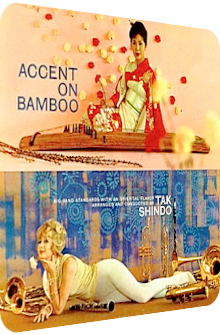
Tak Shindo
Accent On Bamboo
1960
Accent On Bamboo is the third exotic album by the Japanese-American film musician Takeshi "Tak" Shindo (1922–2002) and the second LP where he tries to mediate between a decidedly Western big band setting and the dreamier, more mysterious Far Eastern soundscape with the help of Asian devices and related tone sequences played on otherwise established mallet instruments. As is the case with Shindo’s fourth genre-related album Far East Goes Western of 1962, Accent On Bamboo does not feature exotic material per se. The opposite is the case: Jazz standards and less known material are happily united here. And yet it is a clear-cut Exotica offering, as Shindo is keen on unleashing quite a few Japanese instruments such as the koto (played by himself), shamisen and several claves and woodblocks in adjacency to the Western brass flourish.
Even though the Occidental elements outweigh the Asian infusions, the presence of the latter is palpable enough – although less perceptible than on Shindo’s great Brass And Bamboo of 1959 – to categorize this album as an Exotica work. The usual twelve tunes are featured on this LP, and it is at least as usual for the orchestra leader to add a unique self-written cut to the roster; on this album, it is Festival In Swingtime on side B, and potentially one additional tune whose original writer I do not know thanks to the sparse liner notes. Although I consider myself quite a fan of his talent, Accent On Bamboo is plagued by the degrading quality that was so typical in the Golden Age of the music industry. Side A offers a wide yet consistent variety of catchy material and noteworthy segues and intersections, but side B remains stuck in the so-called big band wagon, with only one particularly dreamy exception. But side A is a blast. Depending on your viewpoint, i.e. if you love big band renditions tremendously much, side B is equally worth your while.
A take on Ray Noble’s 1938 Jazz standard Cherokee opens the LP, and it seems to be arranged by Nelson Riddle at first glance; it is that colorful and relies as much on the orchestra strings as on the wind instruments. Joyful legato brass sections, horn staccato stabs and xylophone underlinings as well as the balmy but jumpy vibraphone infusion together with the plinking triangles make this a decidedly Western take. If the listener is trustful, the xylophones start to deliver traces of Asian magic, and let us not forget the female lead singer who hums along to the melody in the tune’s second section. Cherokee is fully fleshed out, allows for a great, uplifting start, but is not overly exotic in the end. A Space-Age aura is closer at hand, I believe.
The following One Fine Day introduces Far Eastern tonalities for the first time, as the lead trombone is accentuated by two-note sunset-red brass and string concoctions which inherit both conviviality and tension. Best of all, though, is the mysterious lead koto that shuttles around a soothing alto flute melody, but stands on its own feet later on where it is almost chopped down by the brazen sounds of the trumpet. Despite the spiraling double-bass backing, this is a strongly Japanese tune, gentle and mild-mannered, with no traces of romance or kitsch. The same can be said about Harry Warren’s and Mack Gordon’s 1941 smash hit Chattanooga Choo Choo. Presented in a swinging version here with thermal heat-causing brass sections, the triplet of hollow, wonky and elastic sounds made by a koto that is situated in close proximity to the recording microphones takes the cake and elevates this version to the highest regions. Best of all: if you know a little bit about Tak Shindo’s other Japan-influenced albums, you will realize that the koto actually truly works in the context and is neither gimmicky, nor alienating to the connoisseur. A magnificent tune!
Side A continues with I Gotta Have You, and the only other version I know of is interpreted by, ahem, country singer Harold Franklin "Hawkshaw" Hawkins. Being an accidental foreshadowing device of Shindo’s aforementioned country-influenced album Far East Goes Western, the arrangement consists of the banjo-like shamisen in tandem with xylophone blebs, both of which are themselves embedded in-between big band soundscapes and a freely flowing lead saxophone. The focus lies on the Occident, but the ensuing fragility and eupeptic wondrousness of the Country-adapting shamisen are the bonus of an otherwise lackluster Jazz theme. Speaking of Country music: Alec Wilder’s It’s So Peaceful In The Country is transformed into a nocturnal technicolor landscape by wonderful guitar twangs, a mellifluous mélange of dulcet flute tones, a luring chantress, harp-like koto cascades and a gorgeous lead melody on the same instrument that is allowed to breathe and unfold thanks to the careful double bass underpinnings and the many fissures and pauses that make this a genuinely dreamy tune and a feast for fans of Far Eastern Exotica music. It is admittedly saccharine, but does capture the poeticizing nature of moon-lit Steppes or meadows with ease.
The final track on this side consists of the excellent Portrait In Blue, which is built on a similar tempo, but fills the soundscape with an interesting interplay of screeching trumpets, mellower intersections and a koto/shamisen couple that oscillates between a mundane Country style and a larger majesty. It is here that the temple gongs are used in a bold session for the first time on Accent On Bamboo. And don’t get me started on the enigmatic flute melodies that counteract against the sparkling spotlights of the brass instruments. Portrait In Blue is one of Shindo’s very best cuts!
Side B continues the successful formula of meshing the East with the West, be it the big band-era opener A String Of Pearls by Jerry Gray and Eddie DeLange with its effervescent trumpet improvisation, the epicurean takeover on the saxophone and the koto vesicles in darker ranges, or a take on Paul Whiteman’s 1922 composition Stumbling that relies on the same big band rhythms, but boosts the luminosity with soft cymbals, clinging triangles and sky-high tambourins. The upwards spiraling five-note melody is realized on the koto, and the crowded soundscape luckily allows its sustain to conflate with the distance nonetheless. Alas, both tunes cannot hoodwink the growing weariness of the formula, but to be honest, this danger is faced by each and every of Shindo’s Exotica-related albums (except his magnificent ever-changing faux-African tale and debut Mganga! of 1958).
And so side B goes down the big band path with three of its four remaining tracks: Shindo's take on Jack Yellen’s and Sam E. Fain’s Happy In Love places the shamisen droplets in the background, favors the Western timpani and snare drums and unleashes further improvisations on a piercing trumpet, and it is only the return to dreamier realms thanks to a tune called For You that turns out to be the combo breaker of the brassy panorama due to its magnificent wind chimes, the fully fleshed-out koto main melody, iridescent glockenspiels, moony vibraphones and gossamer horns. This is a gemstone of a tune and a huge favorite of mine! The horns are subordinate and slaves to the Asian feeling. Tak Shindo’s own Festival In Swingtime brings back Crime Jazz-like droning brass bursts and the most sizzling-hot klaxon trumpets on any of his tunes. However, one little particularity is enchanting: the heretofore unused solemnity of the spring-evoking orchestra bells. These chime devices alone rescue this tune from becoming a big band composition by the numbers.
The final Kiss Me Again off the eponymous 1931 operetta with music written by Julien Josephson and Paul Perez finishes the album with potential show tune qualities and related hooks, but disappoints and frustrates due to the exclusion of almost the entire Far Eastern instrumental pool, with only scents of koto twangs left. A few tambourins here, flowing vibraphones there and plinking triangles in close proximity may evoke lightness and ease, but do not encompass the album title, nor meet the demands that were set and nurtured by the high quality of side A.
Accent On Bamboo is seen as the inferior child by Exotica fans in direct comparison to Brass And Bamboo, and indeed does the latter not only feature tropical versions of Jazz standards, but comprises of Asian versions of Exotica classics as well. So in this regard, Brass And Bamboo is the stronger work and presents a largely broader scope with additional women in the choir and better-known melodies. But people forget Tak Shindo's third Asia-related work called Far East Goes Western which was briefly mentioned in the opening paragraph. If you throw it into the ring with the other albums, Accent On Bamboo suddenly shines! The Western brass melodies are usually vivid and offer a delightful amount of freestyle improvisations in the otherwise crammed soundscape, with the Asian glitz being perceptible most of the time, although the koto and shamisen are unfortunately degraded as underlining devices all too often. But the arrangements where they are prominently featured are almost gold standards of the genre: the dreamy moon-lit luminescence of It’s So Peaceful In The Country and the equally moony For You are prime examples of Shindo's will to provide a more reduced approach; probably unintentionally, these are the actual mellow stars of all of his albums, as the characteristic trait and delicately liquid sustain of the Far Eastern instruments works best in quieter surroundings, with them being on the forefront.
I have to admit that this is not the dedicated raison'dêtre of this release, which is based on the more or less harmonious mediation between multiple brass players and scattered exotic scents. While Brass And Bamboo can be called an Exotica record due to its inclusion of hits like Bali Ha'i, the definite answer in terms of Accent On Bamboo is much trickier. I am willed to count it to the Exotica canon as well. The big band tunes may seem perfectly bland and uninteresting, but the Japanese instruments work well there. And let's not forget the mallet instruments which oscillate in the strongest way between the two distinct worlds of music. Whatever you make of Accent On Bamboo, is it easily available for a fair price in digital download stores, although not in every larger country – business as usual. Big band admirers and fans of that Manhattan sound with its illuminated concrete jungle skylines will get the most out of it, but chances are that if you acknowledge Brass And Bamboo, you will be quite a bit fond of the follow-up as well.
Exotica Review 152: Tak Shindo – Accent On Bamboo (1960). Originally published on Dec. 1, 2012 at AmbientExotica.com.
